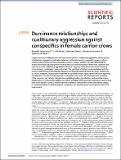Files in this item
Dominance relationships and coalitionary aggression against conspecifics in female carrion crows
Item metadata
| dc.contributor.author | Holtmann, Benedikt | |
| dc.contributor.author | Buskas, Julia | |
| dc.contributor.author | Steele, Matthew | |
| dc.contributor.author | Solokovskis, Kristaps | |
| dc.contributor.author | Wolf, Jochen B. W. | |
| dc.date.accessioned | 2020-10-05T16:30:02Z | |
| dc.date.available | 2020-10-05T16:30:02Z | |
| dc.date.issued | 2019-11-04 | |
| dc.identifier.citation | Holtmann , B , Buskas , J , Steele , M , Solokovskis , K & Wolf , J B W 2019 , ' Dominance relationships and coalitionary aggression against conspecifics in female carrion crows ' , Scientific Reports , vol. 9 , 15922 . https://doi.org/10.1038/s41598-019-52177-7 | en |
| dc.identifier.issn | 2045-2322 | |
| dc.identifier.other | PURE: 270357011 | |
| dc.identifier.other | PURE UUID: e82d9c78-27ab-4ebe-90aa-79c5f3098e79 | |
| dc.identifier.other | WOS: 000493898100030 | |
| dc.identifier.other | Scopus: 85074340785 | |
| dc.identifier.other | ORCID: /0000-0003-1360-4762/work/80995375 | |
| dc.identifier.uri | https://hdl.handle.net/10023/20725 | |
| dc.description | Funding: European Research Council (ERCStG-336536 FuncSpecGen to J.W.), the Swedish Research Council Vetenskapsrådet (621-2013-4510 to J.W.), Knut and Alice Wallenberg Foundation (to J.W.) and Tovetorp fieldstation through Stockholm University. | en |
| dc.description.abstract | Cooperation is a prevailing feature of many animal systems. Coalitionary aggression, where a group of individuals engages in coordinated behaviour to the detriment of conspecific targets, is a form of cooperation involving complex social interactions. To date, evidence has been dominated by studies in humans and other primates with a clear bias towards studies of male-male coalitions. We here characterize coalitionary aggression behaviour in a group of female carrion crows consisting of recruitment, coordinated chase, and attack. The individual of highest social rank liaised with the second most dominant individual to engage in coordinated chase and attack of a lower ranked crow on several occasions. Despite active intervention by the third most highly ranked individual opposing the offenders, the attack finally resulted in the death of the victim. All individuals were unrelated, of the same sex, and naive to the behaviour excluding kinship, reproduction, and social learning as possible drivers. Instead, the coalition may reflect a strategy of the dominant individual to secure long-term social benefits. Overall, the study provides evidence that members of the crow family engage in coordinated alliances directed against conspecifics as a possible means to manipulate their social environment. | |
| dc.format.extent | 8 | |
| dc.language.iso | eng | |
| dc.relation.ispartof | Scientific Reports | en |
| dc.subject | 3rd-Party affiliation | en |
| dc.subject | Social intelligence | en |
| dc.subject | Alliance formation | en |
| dc.subject | Brain size | en |
| dc.subject | Evolution | en |
| dc.subject | Cooperation | en |
| dc.subject | Cognition | en |
| dc.subject | Patterns | en |
| dc.subject | Ranking | en |
| dc.subject | Rooks | en |
| dc.subject | QH301 Biology | en |
| dc.subject | DAS | en |
| dc.subject.lcc | QH301 | en |
| dc.title | Dominance relationships and coalitionary aggression against conspecifics in female carrion crows | en |
| dc.type | Journal article | en |
| dc.description.version | Publisher PDF | en |
| dc.contributor.institution | University of St Andrews. School of Biology | en |
| dc.identifier.doi | https://doi.org/10.1038/s41598-019-52177-7 | |
| dc.description.status | Peer reviewed | en |
This item appears in the following Collection(s)
Items in the St Andrews Research Repository are protected by copyright, with all rights reserved, unless otherwise indicated.

